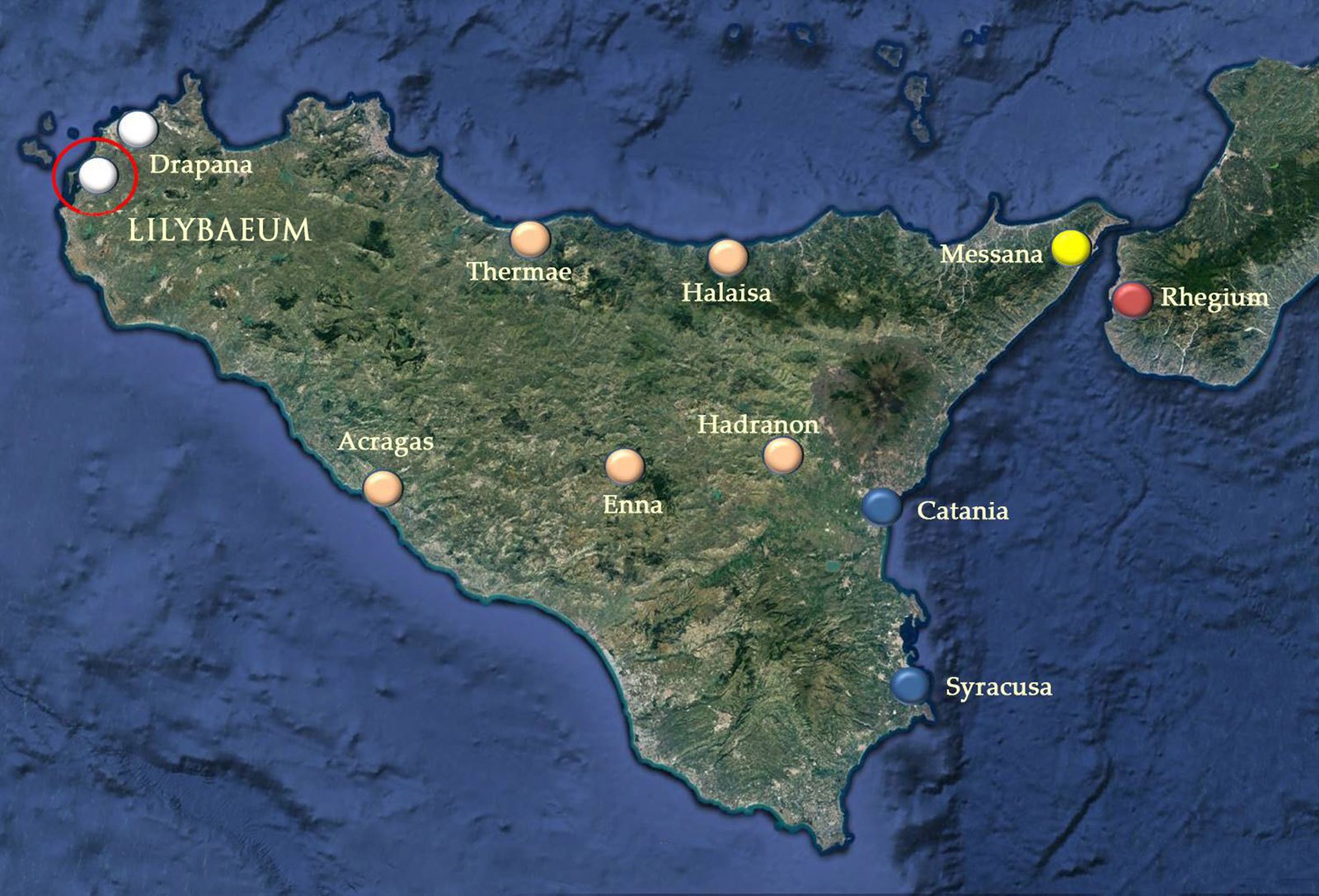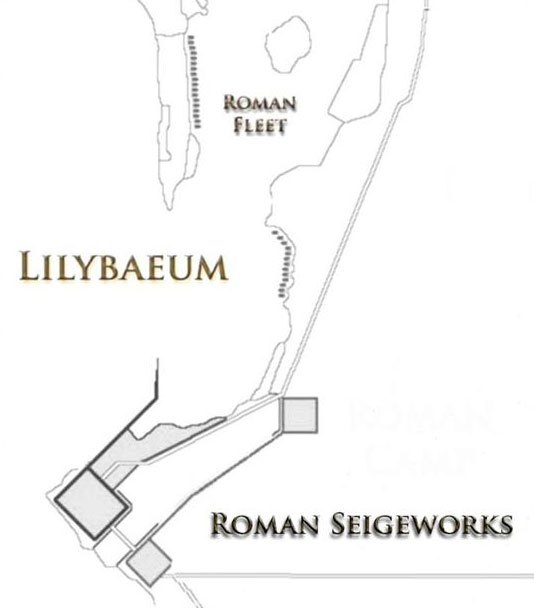First Punic War—264-241 BC
Phase 4: Return to Sicily, 254-241 BC
The tragedy off the southern Sicilian coast caused the Carthaginians to renew challenge to the Romans on sea and on land. They built a fleet of 200 warships and mobilized a new army that they landed in Lilybaeum (on the western Sicilian coast) where the general Hasdrubal began training his troops in earnest with the intention of challenging the Roman hold on Sicily.
The Romans, although chastened by this double blow, raised a new fleet of 220 ships in order to make good their losses and maintain their ascendency at sea. They accomplished this within 3 months, and married these new ships to the surviving 80, producing another formidable fleet capable of meeting the Carthaginians on its own terms. This armada, sailed in the summer of 254 BC and promptly blockaded and invested Panormus (modern Palermo), a Carthaginian stronghold, took and garrisoned the city, then sailed back to Rome.
253 BC
The following year, the Roman fleet sailed along the African coast where they accomplished nothing. However, on their return trip to Rome from Panormus, they encountered a storm and lost 150 ships. Polybius goes on to say that “At this point, the Roman government, in spite of their habitual and inflexible determination to succeed in all their undertakings, were compelled in view of the gigantic scale and frequency of the disasters they had suffered to abandon the idea of building yet another fleet.” The Romans decided to withdraw from the sea and to concentrate on their land forces. This allowed the Carthaginians to retake command of the sea without so much as a single naval victory.
Polybius. The Rise of the Roman Empire. Ian Scott-Kilvert (Trans.), 1979. Penguin Books, Ltd. London. p. 82.
250 BC
This is a key victory by the Romans, led by Caecilius, over the Carthaginians before the walls of Panormus. Hasdrubal, overconfident, attacks Roman troops before the town. Roman tactics cause elephants to stampede and break up Carthaginian formation. Carthaginians suffer heavy losses. This win restores confidence to Roman troops after the disastrous defeat in Africa and the catastrophic losses at sea.
Senate sends out a rebuilt fleet of 120 ships (Polybius says 200) to blockade Lilybaeum on the west coast of Sicily. A Roman army invests the city from the landward side.
Lilybaeum is defended by a garrison of 10,000 Celts and Greeks
Polybius goes on to say: “Meanwhile the Carthaginian authorities at home were quite unaware of these events. But they had in any case to consider the needs of a besieged city, and so they manned fifty ships, filled them with troops, and after giving instructions suitable to the operation in hand, dispatched them at once under the command of Hannibal, the son of Hamilcar, who was both a triarch and the trusted colleague of Adherbal. Hannibal’s orders were that he should on no account delay but should seize the first opportunity to make a bold attempt at relieving the beleaguered city. Accordingly, he put to sea with 10,000 troops on board, anchored off the Aegares Islands which lie between Lilybaeum and Carthage, and there waited for favorable weather. As soon as he had a good breeze from astern he hoisted all sail and running before the wind made straight for the mouth of the harbor, with his men drawn up on the decks armed and ready for action. The Romans were taken unawares by the sudden appearance of his fleet, and they were also afraid of being swept by the force of the wind into their enemies’ harbor in the midst of a hostile force, and so they made no attempt to bar the entry of the relieving fleet; instead they remained standing out at sea, still half lost in amazement at the audacity of the Carthaginians.
Meanwhile, the whole population of Lilybaeum had crowded on to the walls. They were in an agony of anxiety for the outcome, yet at the same time overjoyed at the unexpected prospect of rescue; then, as the fleet sailed into the harbor they greeted it with loud cheers and clapping of their hands. Then Hannibal, having brought off this daring and risky feat of entering the harbor, dropped anchor and safely disembarked his troops.”
Roman investment and blockade of Lilybaeum. The Romans built a wall that circumvallated the walls of the city. The siege wall was anchored at each end by a Roman camp. The Roman fleet completed the encirclement.
Polybius. The Rise of the Roman Empire. Ian Scott-Kilvert (Trans.), 1979. Penguin Books, Ltd. London. p. 89-90.
The Carthaginian garrison attacks the Roman siege works with fire and aided by the weather (wind blowing toward the Roman side) damages the siege towers and causes a substantial number of casualties to the Roman fleet. The Romans realize that they will not be able to take the city by storm and settle down to starving the town out. The Romans recruit and send another 10,000 sailors to replenish the blockading fleet at Lilybaeum. Upon arriving at the town, the Roman commander organizes an attack on the Carthaginian fleet at Drepana (about 15 miles north of Lilybaeum). The Roman fleet is defeated, losing 93 ships and crews to the Carthaginians. The Romans recruit and replenish their fleet once again (another 120 ships). This fleet is blocked by a Carthaginian fleet from reaching Lilybaeum and destroyed by a storm. Nevertheless, the Romans remain determined to continue the siege at Lilybaeum.
246 BC
The Senate creates a second pair of praetors to lighten the consuls’ judicial burden and to provide another magistrate with imperium for the purpose of leading another army in the field.
242 BC
Hamilcar Barca and the Carthaginian forces showed initiative on land. The Romans, recognizing a strong opponent made their strategy of focusing on land efforts to win the war questionable, revived their efforts at sea. The Roman treasury was empty, so wealthy Roman citizens showed their patriotism by financing the construction of one ship apiece. In this way the state was able to raise a new 200-ship war fleet with crews. In the meantime, the Carthaginians also built a new fleet (250 sail) under the command of Admiral Hanno. The Roman fleet under the command of consul Gaius Lutatius Catulus, trained the crews until they were proficient and prepared for combat.
241 BC
The Romans reinvested Lilybaeum and Catulus blockaded the city from the sea. The Carthaginian fleet under Hanno, carrying supplies and reinforcements for Carthaginian land troops, was heavily weighed down and manned by inexperienced crews. The Romans carried only bare necessities, so their ships were lighter and, because they had abandoned the Corvus, more maneuverable. The praetor Quintus Velerius Falto commanded the Roman fleet because Catulus was sidelined with injuries.
The Romans achieved a naval victory at Aegusa (off of the Aegadian Islands), sinking or capturing half of the Carthaginian ships and taking 10,000 Carthaginians prisoner, which enabled them to deny the Carthaginian land forces a line of supply. This, despite their exhaustion and extremely heavy losses, enabled the Romans to finally achieve a strategic advantage against the Carthaginians.
Consequently, Lilybaeum was taken and Hamilcar Barca’s army in Sicily isolated. The Carthaginians sued for peace.


